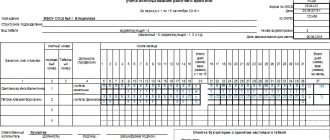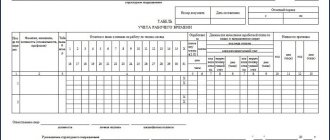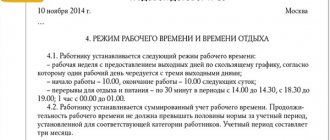Why is it necessary to keep track of working hours?
Timing of working time is understood as a process during which an employee, independently or with the assistance of colleagues who have the necessary competencies, monitors his own actions while at work for their content and duration.
Timing thus records what exactly an employee does during working hours, as well as how long each of his activities lasts. Why is this necessary?
First of all, the employer is interested in keeping track of employees' working hours - in order to evaluate and improve the efficiency of staff work. In addition, timing can also be used to:
- equipment load assessments;
- assessing the effectiveness of the implementation of management decisions in terms of individual business processes (and subsequent determination of the mechanisms for their necessary adjustment).
Through this procedure, the employer can identify:
- the percentage of employees performing useful actions during working hours;
- duration of downtime or actions not related to the work function;
- how the first 2 indicators change over time - when comparing several timings carried out in a row.
Timing is, in essence, an inventory of working time: identifying its quantitative indicators in relation to local business processes (production, management).
The employee himself may also be interested in keeping track of his working time - in order to increase work productivity, which will result in more intensive implementation of plans, if any, and ultimately - receiving a higher salary.
The initiators of the timing of working hours at an enterprise can be different subjects: business owners who are interested in increasing labor productivity; top managers of the company, also interested in achieving high production indicators; heads of departments; ordinary employees.
There are 3 main operations within the timing of working hours:
- preparation of timekeeping forms - for a specific position or job function;
- collecting data (filling out appropriate forms) in relation to the employee’s time at work;
- analysis and interpretation of timing data.
Let us consider the features of each of these operations in more detail.
Timing of the day: analysis of the current situation
It’s worth making a reservation right away: not a single example or sample of working day timing will help to understand the process of accounting and time control. Therefore, it’s worth doing everything yourself – even if it’s for a couple of days, but by yourself. Based on the results of the table, you can see the main points:
- Standard and common chronophages. These are the real bottlenecks in our planning. But anything can be a chronophage - even a meeting of the board of directors of a company, if water is pouring there and nothing worthwhile is discussed.
- Tasks for which there is not enough time. How to calculate the time resource has already been discussed, but only timing will show how to find this time.
- Calculate the amount of “lost” time, all sorts of useful coefficients and draw the necessary conclusions.
This information will give you a lot. They will teach you to value time, help you see the inexpediency of some things, show you where to look for resources, and, most importantly, allow you to move directly towards your goals. Because the most important thing in moving towards a dream is the time that we can allocate to take specific steps.
Of course, you can trust the techniques of wish fulfillment and shamanic practices , but it is better to combine esotericism and real working methods.
How to prepare forms for timekeeping?
When preparing timekeeping forms, it is important to first determine:
- what actions or activities of the employee while at work will be recorded;
- in what units of measurement the duration of the corresponding actions or activities will be reflected.
So, timing objects can be:
- actions in the main computer program through which the employee performs his job function, for example, “1C” if he is an accountant, or Photoshop if he is a designer;
- making telephone calls by an employee;
- employee writing emails;
- employee participation in meetings and planning sessions;
- breaks from work - for tea, lunch;
- other actions within the office that have no connection with the work function, but are an integral part of the work process, such as changing clothes, loading a PC, waiting for updates to its databases and software components.
Timing can be carried out in connection with a specific technological process - for example, to the stages of production of goods produced on the factory line of an enterprise. In this case, timing objects can be:
- loading materials onto the conveyor;
- assembly of the product on a conveyor;
- checking the quality of the assembled product;
- descent of the finished and tested product from the assembly line.
Or the same processes, but performed by specific workers (responsible for loading, assembly, etc.).
Regarding the units of measurement of the duration of an employee’s actions or activities, these can be expressed in seconds, minutes, hours, and sometimes days. Their choice depends, first of all, on the goals set by the company or its division responsible for timekeeping - to improve the employee’s productivity during the work shift (or part of it - for example, before lunch), week or month.
Working day photo, sample
Card of an individual photograph of an accountant's working day at Asphalt LLC Division: Accounting Observation date: 10.10.2018 Working hours: from 8.00 to 17.00, lunch break: from 12.00 to 13.00 Full name: Vasilieva Vasilisa Vasilievna Position (profession): leading accountant (debtors and creditors) Experience, full years: 5 yearsN p/n Name of elements of the operation (labor process) Current time Duration (hour, min)1 2 3 41 Start of the working day 8:002 Preparation of the workplace (turning on the computer, office equipment) 8:00 0:053 Maintenance of the worker places 8:05 0:054 Work with documents (including studying the regulatory framework) 8:10 0:305 Interaction with those responsible in departments on documents on the basis of which turnover for debtors and creditors is formed 8:40 1:006 Reception , checking for correctness of execution and filling, registration in the accounting program 1-C - Accounting of documents confirming turnover with debtors and creditors 9:40 0:407 Personal needs (micro-pause) 10:20 0:058 Reception, checking for correctness of execution and filling , registration in the accounting program 1-C - Accounting of documents confirming turnover with debtors and creditors 10:25 1:309 Personal needs (micro-pause) 11:55 0:0510 Lunch break from 12:00 to 12:30 12:00 1: 0011 Drawing up a register of accounts payable based on invoices for payment and agreeing on the order of payment of bills with the manager 13:00 0:3012 Drawing up a balance sheet, tracking accounts receivable
How is timing data collected?
This problem can be solved by:
- manually entering data into timekeeping forms;
- automated data entry into appropriate forms.
In the first case, the main actions may be assigned to the employee himself or to a responsible person who will supervise the employee’s work. The second option for collecting timing data involves the use of various computer algorithms.
The choice of the first or second option for data collection depends on the specifics of the employee’s specific job function, as well as on the technical ability and efficiency of recording this or that type of data for timing in the first or second way.
For example, if we are talking about recording data on the use of programs specialized for a person’s work function, then the optimal way to solve this problem is automation, which involves the use of other programs that can track the intensity with which the employee accesses his software.
When it comes to timing the stages of a product assembly line, it may be preferable (due to less complex technical feasibility) to use a method of manually entering data into the timing form.
Once the timing data is collected, the employee or his colleague who has the necessary competencies has another task - to correctly interpret the statistics obtained.
How to obtain employee consent
The employee has the right to give oral or written consent to the photograph. Verbal - when an employee says: “Okay, use my photo.” Written - the same thing, but by email or SMS.
My advice is to get written consent. Oral agreements may be forgotten, and in the event of a conflict there will be no evidence that the employee agreed. If a store uses personal data along with a photo, Roskomnadzor may ask for consent to process the data. In general, we turn on the bureaucracy and prepare the papers.
Consent does not have a mandatory form - the main thing is that it is clear: who is agreeing to what. The agreement may include:
- who gives consent to the photograph;
- which company;
- where the photographs will be used or for what purposes. You can write, “in the 2021 catalog” or “for advertising purposes”;
- what photographs are consented to? For example, for one image or an entire photo shoot;
- consent to transfer photographs to third parties. This is necessary so that the designer and printing house can work with photographs. It is not necessary to list exactly who gets access, but you can write examples. This will help the employee understand what is being said;
- terms of use of consent. Leave specific deadlines - “until December 10, 2021” or “indefinitely”;
- the area in which the photograph will be used. If the catalog is distributed in Russia, we indicate Russia. If we are talking about a website, it is better to write “the whole world.”
Consent might look like this:
If the store printed the booklet but did not receive consent, this can be done now. Add the date of the last shoot to the consent, and you’re done. Let’s say an employee filmed in October, but gives permission in November. Then the agreement will contain the phrase:
“The consent applies to all images taken after October 1, 2021.”
Consent must be kept for at least three years - this is the period when an employee has the right to sue because the employer uses his photograph.
How is timing interpreted?
Timing data can be interpreted through:
- visualization of employee action statistics;
- factorial, comparative analysis of relevant statistics;
- identifying dependencies between indicators reflecting the dynamics of actions performed by an employee and indicators of economic importance (for example, the number of goods produced over a specified period of time).
Often all of these methods of interpreting timing data are performed simultaneously by the employee or a competent colleague.
Based on the data obtained during timekeeping, as well as their analysis, the enterprise can make certain personnel decisions, issue methodological recommendations on improving the quality of employees’ performance of work functions, generate analytical reports for investors - the options for possible application of the results of timekeeping can be very different.
Experience in organizing the work of a secretary of an independent self-supporting unit
V.A. Slepova, L.R. Fionova, Penza State. university
|
|
SHP "Start-Energo" is a branch of the Federal State Unitary Enterprise FSPC "PO "Start" named after. M.V.Protsenko" Zarechny, Penza region (Figure 1). The division was created in 2010 on the basis of an order from the General Director of the Federal State Unitary Enterprise for Research and Production named after M.V. Protsenko." SHP "Start-Energo" is a separate division, in accordance with the legislation of the Russian Federation, its founder is the Federal State Unitary Enterprise FSPC "PO "Start" named after M.V. Protsenko." SHP "Start-Energo" was created to implement:
- heat supply to the plant and city;
- hot water supply for factories and cities;
- water supply to the plant and city;
- plant and city water disposal;
- electricity transmission services.
The procedure for organizing the work of the agricultural enterprise "Start-Energo" is determined by the "Regulations on the agricultural enterprise "Start-Energo"", which is approved by order of the general director of the FSUE FSPC PO "Start" named after. M.V. Protsenko.” SHP “Start-Energo” is not a legal entity; it operates on behalf of the founder and fulfills the founder’s duties for paying taxes, acquires property and personal non-property rights.
SHP "Start-Energo" is headed by a director appointed by the general director of the Federal State Unitary Enterprise FSPC "PO "Start" named after M.V. Protsenko”, his rights and obligations are regulated by the conclusion of an employment contract. The director is directly subordinate to a deputy director, a legal adviser, a secretary, a chief designer, a chief mechanic, a chief engineer, a chief technologist, a chief electrician, and a chief accountant. In the staffing table of the department there is no special position or department dealing with office work issues, therefore all issues of documentation support of the department (DOU) are assigned to the secretary.
The secretary carries out work on organizational and technical support for the administrative and administrative activities of the manager, accepts correspondence received for consideration by the manager, transmits it to structural units or a specific performer, answers telephone calls, records and transmits official information to the manager, organizes telephone conversations of the manager, composes letters , requests, other documents., carries out work on preparing meetings and conferences, organizes the reception of visitors, facilitates the prompt consideration of requests and proposals of employees., forms files in accordance with the approved nomenclature, ensures their safety, and archives them.
The activities of the secretary of the Start-Energo agricultural enterprise are regulated by local regulatory documents, which include:
Regulations on the agricultural enterprise “Start-Energo”;
2. Internal labor regulations;
3. Job description of the secretary.
The regulations were approved by order of the General Director of the Federal State Unitary Enterprise FSPC "PO Start" named after. M.V. Protsenko” dated April 21, 2010 No. 249. It defines the order of organization, the main directions of activity, structure, functions and tasks of the unit.
The internal labor regulations (approved by order of the director dated May 4, 2010 No. 01) establish the procedure for organizing work, which is mandatory for all employees, including the secretary.
The job description of the secretary was approved by order of the director dated May 15, 2010 No. 24. This document defines the requirements for education, qualifications, hiring procedures, main duties, rights and responsibilities of the secretary. As in any organization, in SHP “Start-Energo” three streams of documents can be distinguished: incoming documents; internal documents; outgoing documents. Recently, the Start-Energo agricultural enterprise has seen a tendency to increase document flow, the basis for this is the expansion of the customer base and, as a consequence, an increase in the number of orders of the organization (Table 1).
Table 1 – Number of documents for 2009-2011
| 2009 | Internal documents |
| Outgoing documents | |
| Incoming documents | |
| Internal documents | |
| Outgoing documents | |
| Incoming documents | |
| Internal documents | |
| Outgoing documents | |
| Incoming documents |
The volume of document flow of the agricultural enterprise "Start-Energo" for 2009-2011 is presented in Fig. 2.
Rice. 2 – Volume of document flow of agricultural enterprise “Start-Energo” for 2009-2011
The secretary's working day begins with receiving and processing incoming documents. Delivery to the Start-Energo agricultural enterprise is carried out by postal services and by e-mail or fax. Correspondence is delivered in the form of simple letters, notification letters, parcels and packages, as well as printed publications. After receiving the document, the secretary checks the correctness of delivery: checks the integrity of the packaging, opens the envelope and checks the safety of the attachments. Further, if the letter contains a return address, the envelope is destroyed. The secretary does not open envelopes marked “personally” or “confidentially”, he transfers them “into the hands” of the addressee. The secretary preliminary reviews the documents in order to identify those that are not registered. After this, the secretary registers the remaining documents in the registration and journal form presented in Fig. 3.
Fig 3 – Incoming correspondence log The incoming document log includes the following columns:
The registered document is submitted to management for review. The review of the document by the manager ends with the application of a resolution, which determines the further movement of the document. Next, the secretary submits the documents for execution.
After completing the assignment, the executor returns the document to the secretary. Next, the secretary files the document in the file, indicating the number and sheet of the file in the registration and journal form. The path of the document from the moment it is received to the moment it is filed in the file can be traced on the operogram presented in Table 2.
Table 2 – Operagram for the movement of incoming documentation
The beginning of preparing an outgoing document is the creation of a draft document by the secretary. Outgoing documents to SHP "Strat-Energo" include: certificates, letters. In Fig. Figure 4 shows a histogram showing the volume of outgoing correspondence. As can be seen from the histogram, the largest volume of outgoing correspondence consists of letters.
Rice. 4 – Histogram of the ratio of outgoing correspondence
Outgoing documents that do not require the approval of the chief accountant are sent immediately to the director for signature. All outgoing documents are subject to registration. The Start-Energo agricultural enterprise maintains a journal form for recording outgoing documents, since it is important for the secretary to keep records of documents. The log of outgoing documents includes the following columns:
After the secretary has registered a document, he determines whether the document needs to be replicated and, if necessary, prepares a mailing list. Outgoing documents from the Start-Energo agricultural enterprise are sent by mail, e-mail, and also by fax. After the document is sent, either by mail or via e-mail, the secretary writes off the second copy of the document being sent into the file.
The percentage of delivery methods and sending documents to the Start-Energo agricultural enterprise is presented in Fig. 5. The beginning of the preparation of an internal document is the creation of a draft document by the secretary. Internal documents in SHP "Strat-Energo" include: instructions, orders, protocols, memos.
Documents that do not require the approval of the chief accountant are sent immediately to the director for signature.
Rice. 5 – Diagram of the relationship between methods of delivery and sending of documents
In Fig. Figure 6 shows a histogram showing the volume of internal documents. Rice. 6 – Histogram of the ratio of internal documents As can be seen from the histogram, the largest volume in internal documents consists of orders and instructions. An example of an order is shown in Fig. 7. You may notice that the approval is not drawn up quite correctly; it is better to do it on the reverse side and in the form of a visa, rather than the approval stamp. The secretary enters information about the internal document into the appropriate registration journal and copies the document. The log of internal documents includes the following columns:
Subsequently, after execution, the secretary files the documents in the file.
Rice. 7 – Example of an order
In his activities, the secretary deals with internal memos, which are used for correspondence between structural divisions of the organization or officials.
During the working day, the secretary performs a variety of technological operations. The most numerous types of work that the secretary is involved in are document services for the manager (Table 3).
Table 3 – Photo of the working day
| In order to competently and quickly complete the work at hand, the secretary must have clearly developed office work instructions. They will help minimize errors in document preparation. In addition, he must use generally accepted recommendations for conducting telephone conversations and receiving visitors, because Receiving visitors and making telephone conversations takes up most of the secretary's working time. The secretary is the link between all employees of the Start-Energo agricultural enterprise and its clients. The efficiency of the enterprise depends on the quality of its work. |
Labor rationing in the accounting service. Features of calculations
Department heads and company directors are regularly forced to evaluate how busy their subordinates are.
Firstly, this is necessary in order to understand whether employees are coping with their work. If they fail, is it because they are not working at full capacity or, conversely, are they not able to complete all the tasks because the company does not have enough people? To answer this question, a workload assessment is needed. And secondly, in order to justify to senior management the need to hire new employees or reduce existing ones.
The workload of different specialists is assessed differently. The work of a journalist is measured by the volume and number of texts, the amount of work of a teacher is measured by hours and the number of students. To assess the efficiency of these specialists, the deadlines and the number of proofreading and editorial changes are used - in the case of a journalist, the results of tests and tests - in the case of a teacher. But measuring the volume of work and its quality in other specialties can be much more difficult. For example, how to determine the amount of work and efficiency of an accountant?
The method of factor rationing is actively used abroad, but it has not yet become widespread in Russia. But first, it’s worth understanding the very concept of rationing and its types.
Rationing is the determination of labor cost standards for specific processes or operations (that is, the required amount of time for one employee to obtain a unit of result). Labor cost standards are the required number of man-hours (or other units of measurement) to obtain a unit of work result. First you need to calculate the current labor costs at the enterprise or in the department, then compare them with pre-calculated standards. The type of standardization used for different companies depends on the method of calculating these standards.
Obviously, any production process can be the subject of regulation. But is it possible to make accounting such an object? To do this, you need to make sure that the accounting process is not unique. It implies the presence of such components as performers, incoming information, rules and regulations (legislative and local), established practice and the output result (accounting statements).
Previously, microelement rationing and timing in production were popular in our country. There were entire volumes of standards for various specialties. But with the development of automation and changes in technology, this method has ceased to be profitable and convenient: the standards would have to be changed too often, and a huge staff of raters with a stopwatch who will measure the time of each worker’s action is not what modern production strives for. In addition, timing and microelement rationing methods are only suitable for industrial operations. And today, companies also need to standardize business processes.
The workday photography method, similar to timekeeping, involves recording all the employee’s actions during the day, including rest time. This method is also more relevant in production, and in the case of intellectual work it will help a specialist manage his working time more effectively.
A more applicable method to business processes is benchmarking. This is a comparison of labor costs for specific processes in different industries. At the same time, the most successful companies in each industry are selected and their standards are accepted as the ideal to which one should strive. This method is quite simple and does not require processing a large amount of information. But it does not take into account the specifics of each company in the industry: business volume, enterprise structure, organization of processes, etc.
The most optimal method for calculating standards for business processes is factor standardization. This is a method in which the required number of employees is calculated taking into account factors affecting the result of work. Let's look at it in more detail.
For factor standardization, it is necessary to divide the activities of the department into processes, for each of which it is necessary to estimate labor costs. Then, for each process, it is necessary to identify the factors that most strongly influence labor costs, and, taking them into account, calculate standards.
The activities of the accounting department can be divided into the following processes:
- accounting of cash transactions; accounting of settlements for banking transactions; accounting of settlements with accountable persons; accounting of settlements with suppliers and contractors; sales accounting;
- management and corporate reporting; accounting for long-term investments, fixed assets and intangible assets; inventory accounting; accounting of financial investments; accounting for financing and loans; tax reporting preparation; payroll preparation.
It is necessary to determine which of these areas are affected by accounting. Next, you need to calculate the labor costs for each process, taking into account the skill levels of the accountants involved. The next step is to identify the factors that most influence labor costs. For example, in the case of a process such as payroll, these factors are: the number of accruals and deductions; number of intersettlements; number of payslips.
In accounting for payments to suppliers:
- number of invoices;
- the average number of item items in the invoice.
After identifying the processes and determining the factors for each process, it is necessary to calculate the standard labor costs. For example, the standard for payroll calculation will be the number of employees (payslips) per month per accountant. And the standard for accounting for settlements with suppliers and contractors can be the number of invoices per hour per accountant.
Example of standard calculations
The company has 200 employees and 3 warehouses.
It is engaged in wholesale trade and works with 62 suppliers.
Each supplier receives 10 deliveries per month to each warehouse.
Each supplier is invoiced twice a month.
Timing of the day: essence and tasks
Timing... The word does not even require translation: “chronos” - time, “meter” - to measure. That is, something to measure time.
Usually a table.
But compiled according to certain rules.
Timekeeping and its importance can be compared to home accounting. To understand where the money goes, you need to keep records of expenses and income in the system. Likewise with time: to understand what hours are spent on and why one minute of rest turns into a day of idleness, it is necessary to take a photograph of the day from a time perspective.
Most often, timing of the working day is recommended; to be honest, it is better to film it over the entire day's length. From morning until the moment of sleep. There will be more sense.
The tasks of timing the day are simple:
- Understand what we spend our irreplaceable time resource on.
- Find untapped reserves of time or learn how to create them.
- Develop a “sense of time” in yourself.
Timing - photography of the day - does not require any special knowledge to perform. It is enough to strictly follow the three recommended steps.
Menu
It consists of taking time measurements of each part of the overall process, which is repeated cyclically with sequential execution until the final stage.
We recommend reading: How to get a tax deduction for a non-working citizen
- Cyclic timing. It combines cyclically repeated quick actions into separate groups for convenience during further study;
- Selective moments.
Such studies are carried out only for a strictly defined operation.
When choosing a methodology and processing the created description, first of all, we focus on the stated goal of conducting chronological research. Why do you need to periodically study in detail how an employee works in production? The answer here cannot be ambiguous, since there are quite a lot of reasons for analysis.
The purposes of conducting research on the labor process of employees can be very different:
- clarification of the detailed structure of the operation;
- how much time is spent on processing the object of labor;








